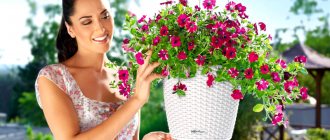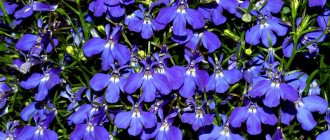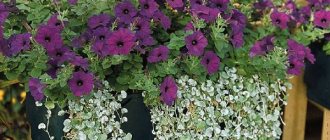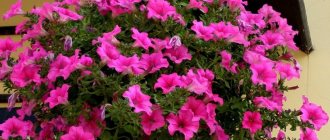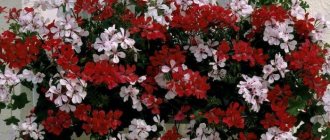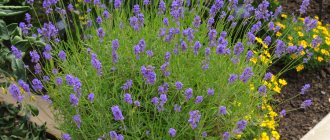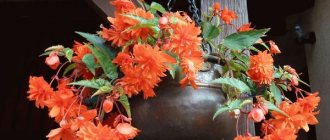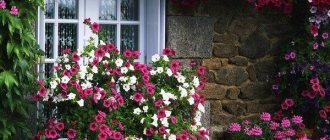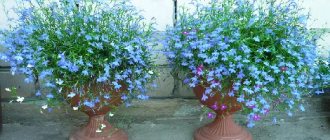Hanging plants are flowers, berries and vegetables that are intended for planting in hanging flowerpots. With their help, experienced flower growers successfully decorate the upper tiers of gazebos, fences and mansions. Even a separate class of flowering crops has appeared - ampelous flowers. This group usually includes ornamental annuals like petunias or lobelias.
However, hanging gardens have much more to offer than simple color variety. In hanging containers, semi-shrubs are especially expressive. With their help, you can create compositions in a room or on a balcony, similar to those usually found in stationary gardens.
Subshrubs and perennials in flowerpots
For example, in the gardens of the southern region, gardeners are often delighted by roses adjacent to or even entwined with thuja or juniper. A similar composition in the style of timeless English classics can be created in a flower pot. Only in it the function of turbulent dense thickets, contrasting with flowers, will be performed by ivy.
An excellent solution is white smart roses and ivy. This combination is somewhat reminiscent of mountain peaks: the snowy-delicate purity of silk petals is in perfect harmony with a lush cascade of clearly defined leaves on long flowing vines.
Such compositions, when bright double ampelous flowers dominate the dense mass of greenery, are quite impressive.
There are other options for combinations with curly hair - more complex or unusual:
- large-flowered bush pelargoniums, framed by thickets of white or blue morning glory, lined with a long edge of awl-shaped phlox;
- tall cyclamens in company with hanging tomatoes hanging from the edges of the flowerpot;
- even ordinary strawberries will look original, and in an ensemble with thyme and oregano they will fill the garden with aroma.
All options are expressive in their own way. At the same time, each of them creates a feeling of freshness and comfort.
Ampelous flowers in pots: a composition pleasing to the eye
The method of growing plants in pots has several advantages. And this is not only accessibility for everyone. There are several more nuances that allow you to have excellent results using a limited amount of effort:
- there is no need to weed;
- loosening the soil is much easier than when planting in open ground;
- the ability to move the plant (relevant during abnormal temperatures and other weather phenomena);
- convenient watering;
- simple transplantation process.
In order for a flower to provide aesthetic pleasure, it must be planted (or replanted) correctly, and the appropriate soil mixture, fertilizing and pot must be selected.
To transplant a flower, you need to choose the right pot, soil mixture and fertilizing.
Note! Before planting (and even purchasing a flowering plant), it is imperative to consult what volume of pot is needed for a particular plant.
The volume can be determined both by the type of flower and by age (for perennials). Some plants also require specific material to make the container.
How to create a beautiful flower arrangement if the pots are different? This is where flower pots come to the rescue - decorative vessels that do not have drainage holes and are designed for placing flower pots in them.
Even if the flowers are in different pots, you can create a beautiful flower arrangement with the help of flowerpots.
To the question of what can be planted in a pot, the answer will be very lengthy, if you list the types of plants, or unambiguous - everything. It is these decorative elements that sometimes combine various street flowers in pots into an interesting composition.
Recently, holes have been made in plastic flower pots, and the products have turned out to be multifunctional – hanging plant pots.
What plants can grow in hanging ensembles
Compositions of hanging flowers for pots allow you to solve two problems:
- create bright plant cascades;
- decorate balconies, terraces, verandas throughout the summer - from April to November.
Ampelous plants for pots have a special habit. The following species can be successfully grown in hanging containers:
- creeping - in which rooting rosettes - stolons - are formed on the shoots;
- curly - those that cling to vertical surfaces with their antennae;
- climbing - vines entwining supports;
- cushion-shaped - forming a rounded dense dome.
Unusual hanging plants are becoming increasingly popular.
Tropical exotics are no longer rare. Vertical gardens are becoming more beautiful and functional every day. Recently, another trend has emerged - to use garden plants in complex compositions.
Conditions for hanging crops
When arranging hanging flowering gardens, it is very important to create suitable conditions for the hanging plants themselves, among which there are light-loving and shade-tolerant varieties. When forming a hanging basket, it is important to select crops with similar growing conditions.
In the bright sun, lobelia, ivy-leaved pelargonium, verbena, and dichondra feel great. Petunia is a universal plant for vertical gardening; the plant tolerates bright light and partial shade.
Pelargonium ivy-leaved
There are special crops for growing in the shade, the queen of which is tuberous begonia. Ampelous varieties of this plant with small leaves and huge multi-colored flowers look perfect in any corner of the garden. Begonia can be planted not only in hanging flowerpots; compositions of these plants are ideal for flowerpots with high legs.
Advice. Among canopy crops, there are moisture-loving and drought-resistant species. It is important to select the plant varieties that make up the basket, taking this aspect into account.
You cannot plant hanging crops in windy places - the leaves and petals quickly lose their fresh appearance and lose their decorative effect. It is best to place decorative flower pots under the protection of building walls or decorative landscape structures.
It is very important to choose the right height for the flowering hanging pots - they should not interfere with the movement of people, the flowers should not be injured by the clothes and bags of passers-by.
New types of plants that are used in canopy gardening
We can say that vertical gardening expands horizons - both literally and figuratively. Flower shops are expanding their range and delighting customers with new types and varieties of hanging flowers. We'll introduce you to some of them.
- Pelargonium ivy - lush caps with bright pink or scarlet inflorescences, very similar to geraniums.
- Bolivian Begonia has cascading, well-leafed stems, densely dotted with red-purple or yellow-orange corollas.
- Fuchsia - cascades of gypsy earrings purple-white or purple-crimson. They remain decorative for 2–3 months.
- Verbena - numerous flowers are collected in dense clusters. There are thin-leaved or leafy varieties.
- Monetary loosestrife, nummularia - flexible flowing vines studded with a scattering of small flowers that look like coins.
- A succession of ferulifolia forms a scattering of bright star-shaped corollas on long curly stems. Similar to the flash of fireworks.
- Diascia. Its flowers resemble snapdragon curls. Thin, soft stems form lush, spreading bushes, abundantly covered with many bright flowers. Looks like a contrasting cloud.
- Saponaria. There are many varieties of saponaria. The most common is soapwort, basilica; it is often grown to decorate flower beds, borders, and rock gardens. A very decorative creeping plant with bright pink flowers.
- Phlox awl-shaped - in a flowerpot it forms an avalanche of flowing bright streams of flowers.
- Morning glory - (yam), with dissected leaf with light green leaf or heart-leaved.
- Plectranthus 1.5 m – with a strong lemon-mint aroma forms a cascade.
- Capitate knotweed - long lashes, forming a cushion, multi-colored leaves
- Mandevilla is a tropical plant. Elegant lashes with leaves collected in star-shaped groups and the same red five-petaled crimson or white flowers resembling bells.
- Tradescantia, many varieties and varieties, leaves of various colors.
- Chlorophytum - forms stolons with air rosettes.
The list of original and rare flowers will be complemented by beautifully fruiting berries and vegetables. Among them:
- ampel strawberry
- hanging tomatoes
You yourself can determine which vegetable can receive the high title of ampelous. If the plant crawls across the lawn, if it climbs a pole or hangs like a whip on the balcony, if it has compact fruits, it can be placed in a hanging container.
What types of flowers are there to grow in pots?
In nature, this group of plants is ground-blooded, and when grown at home, they form lush bushes, the shoots of which gently stretch to the ground. The leaves, which are often shiny, give such flowers a special attractiveness.
To make the hanging flowers beautiful, watering should be done daily, and on hot days - twice a day.
The main types of hanging hanging flowers for flower pots:
- Chlorophytum. This is a perennial decorative deciduous plant with narrow light green leaves. The buds are small. When loosened they have a snow-white hue. This type of plant does not require special care. Chlorophytums are the most unpretentious flowers to grow in pots. They grow well both in the shade and in the sun. Such plants can be planted in any type of soil. The flower tolerates short-term drought well. Even if the leaves have wilted, they recover very quickly after watering.
- Begonia (ampeloid). A profusely flowering crop, with proper care it is abundantly covered with colorful flowers. The buds can reach 8 centimeters in diameter. Depending on the variety, the flowers are double, semi-double or single. They often come in red and coral hues, but also come in orange, white, yellow, crimson and burgundy. Begonia blooms from early spring to late autumn.
- Morning glory or bindweed. This is one of the most popular plants. It can be grown both outdoors and indoors. In order for morning glory to delight with its flowering for a long time, it needs to be provided with a lot of light and watered frequently. What makes the flower unique are the shoots that resemble a vine. The leaf blades are narrow. The flowers are presented in the shape of a funnel; they delight with their unusual appearance for only one day, after which they fade. But this behavior of the plant is little noticeable, since many new buds appear on the shoots every day.
- Fuchsia (ampeloid). An incredibly beautiful plant, the flowers of which can take on different shades. The buds grow to medium size. When loose, they can be terry, single or semi-double. These are the best flowers for planting in flowerpots at the dacha. They are not picky about care. In order for the plant to bloom profusely, it is enough to systematically water it and occasionally feed it.
- Bacopa (ampelic). A perennial variety, but gardeners often use it as an annual. The flowers and leaves are small. They can be white, blue, purple and pink. Bacopa blooms throughout the summer. Wintering is best tolerated on a glazed balcony, where the air temperature is within 50 C.
No less popular hanging flowers for outdoor pots are dichondra, calibrachoa, and petunia.
The latter type, due to the variety of shades, is often used to create interesting compositions. Petunia gained its popularity thanks to its bright and large flowers. If the plant is planted correctly and the minimum care rules are followed, it will decorate the area throughout the entire summer season.
Caring for hanging plants
Plants should be planted in thick-walled containers to reduce the risk of overheating the root system. It is better to choose double-walled flower pots - today there are already containers with built-in water reservoirs and automatic watering.
Potted hanging plants often need weekly feeding. They should be watered daily, sometimes twice a day.
Monitor the condition of the earthen coma. If it dries out, water will not flow to the roots. It will appear in the bottom drain hole, but not because it has saturated the soil. It simply flowed along the walls, and the soil near the roots remained dry.
Follow these simple rules, and your garden will delight you with lush blooms for a long time. And for those who love flowers and are ready to learn all the intricacies of care and cultivation, in our “Floriculture” section you will always find the most up-to-date tips on growing flowers for both beginners and experienced gardeners, articles on garden decoration, sowing features, as well as many other very useful materials.
Flowers for pots: hanging plants in the design of home areas
Many people want to have a house outside the city. This is an opportunity to spend a weekend closer to nature, in peace and solitude, away from the bustle and crowded streets. An obligatory component of a personal plot is outdoor plants. Someone purchased a building on an already green area and simply made adjustments or additions, but more often the arrangement is done from scratch. The desire to contemplate beauty is natural for humans. Considering the abundance of flowers in specialized stores, it will not be difficult to choose the necessary plants or ampelous flowers for pots, so why not surround yourself with this unique natural gift. How to choose flower seeds and not become a victim of deception (read more)
If it is not possible to create a real flower garden, then you can always create a greenhouse from flowers in pots.
Not a single design development, created by a professional or an amateur, is complete without flower beds. They make the structure bright and interesting and bring vibrant natural colors into the surrounding design. Flowers are an uncomplicated, unique way to decorate the most modest landscape. And it is accessible to everyone: if the composition of the soil, lack of space or any other reasons do not allow you to set up a flower garden, you can create a real greenhouse from flowers in pots. On the street, it is appropriate to place them on the ground, along paths, benches, gazebos... Or they can be mounted on a fence, pergola, terrace, or even on the wall of a house. The structure entwined with flowering plants looks truly fabulous.
Even if you don’t have a country house, you shouldn’t deprive yourself of the pleasure of being among flowers in the summer. Pots with plants can be mounted on the outside of the balcony, loggia, and even on the window slope. In specialty stores it is easy to find both the containers themselves and various devices for hanging and installation. It is possible to purchase a pot with a ready-made flower, but you can go from a seed or sprout to a blooming avalanche.
The finished plant option seems simpler only at first glance. It is important to organize adaptation correctly, otherwise the plant will lose its attractiveness. The second way is longer, but with proper care, the beginning of the growing season will bring a lot of pleasure.
Flower pots can be used not only in a country house, but also in a city apartment.
Decorating the site with “bells”: Nolan flower in the design of the territory
Hanging nolana flowers can be a wonderful decoration for a personal plot. This plant appeared on home gardens not long ago, but the demand for it is constantly increasing, since the plant has both high decorative qualities and good resistance to changes in humidity, temperature, and strong winds.
Nolan - “bell”. Indeed, in this hanging plant, the flower stalks resemble bells in shape and color. Small, up to 5 cm in diameter, with carved edges, the flowers come in blue, light blue and violet shades. During the flowering period, nolana produces a pleasant aroma. The leaves are green and succulent, which allows the plant to survive in conditions of significant drought. The flowering period is quite long - from mid-June until the onset of sub-zero temperatures. The stems are creeping, one plant can cover an area of up to 1 m².
On the Internet in the photo, ampelous Nolan flowers are presented in several types: blue inflorescences with a yellow center, blue with a yellow core and white pharynx, purple with small white splashes along the pistil.
It is worth noting that this flower has a tap root system that practically does not branch out to the sides. This must be taken into account when choosing a container for planting.
Hanging nolana flowers can decorate any garden plot.
Design ideas for the garden: hanging plants as part of compositions
Decorating the local area with flower arrangements is a common occurrence. Sometimes there is a garden on a personal plot, which only looks cheerful and elegant when it is in flower. But it can also be decorated with hanging flowers, organizing a small recreation area among the spreading tree crowns. You can use the following ideas.
Place a cart in an open area (so that the sun's rays penetrate) and fill it with pots with hanging flowers. Opposite, in the shade of trees, place a bench. The garden will be filled with colorful flowers, and there will be a great place for privacy and relaxation.
Don't rush to cut down a dead tree! On its branches you can hang pots with hanging flowers - the original oasis will delight you all summer with lush greenery and colorful flowers.
In open areas of the garden, you can place old tubs (and, if desired, new ones) and install flower pots on them. A walk through such a garden will bring a lot of pleasure.
When creating the compositions proposed above or invented independently, it is necessary to select the right plants so that they complement each other and favorably shade each other. To do this, you should pay attention to the photo, the names of hanging plants for the garden and try to purchase specimens that correspond to the image formed in your creative imagination or seen on the Internet.
How to properly care for hanging flowers
Despite the fact that the hanging indoor plants, the names and photos of which we reviewed, are completely unpretentious in care, they require:
- Compliance with temperature conditions. Most of them are tropical plants, and the temperature in the room in winter should not fall below +16 degrees below zero.
- Correct lighting. Hanging vines love partial shade. And if they are placed in direct sunlight, they will get burned.
- Organization of watering. Plants in hanging pots love high moisture. In addition to watering at the root, it is recommended to periodically spray them with a spray bottle.
- Fertilizer application. Indoor plants for pots love light, fertile soil with neutral acidity. It is better to purchase soil for them in specialized garden stores. Complex mineral fertilizers or diluted organic matter are used as fertilizers.
- Timely pruning of missing shoots and faded flowers.
Attention: to prevent the flower from reaching towards the light, the pot with it on the windowsill must be periodically turned in different directions.
Garden hanging flowers
Of the garden hanging plants, the following are in particular demand.
Petunias
They decorate terraces, loggias, gazebos, and porches. They are completely unpretentious in care, cope with various negative environmental factors, and bloom from early summer until late autumn.
Surfinia
A variety of petunia. They have the same positive qualities: ease of care, and the ability to cope with drought, excess moisture, and sudden changes in temperature. They delight summer residents with abundant and elegant flowering throughout the warm season.
Pelargoniums (geraniums)
It is easy to care for and has a large selection of varieties. Breeders have bred more than 250 species of these flowers, differing in color, flowering time, and care requirements.
